Making a smart career move feels more crucial than ever. With a job market navigating economic uncertainty and rapid technological change, choosing an entry-level position is no longer just about getting a foot in the door; it’s about building a foundation for a resilient, future-proof career. For many, this decision comes down to two essential roles: the Marketing Assistant and the Administrative Assistant. While both are fundamental to a company’s success, they represent two distinct paths.
Table of Contents
The core of the Marketing Assistant vs. Administrative Assistant debate hinges on a simple question: are you driven to help a business grow, or are you uniquely skilled at helping it run? A Marketing Assistant focuses on executing campaigns and creative tasks to generate leads, while an Administrative Assistant ensures the smooth operational flow of a department through organizational and procedural support. The former is a role centered on business growth; the latter is centered on business efficiency.
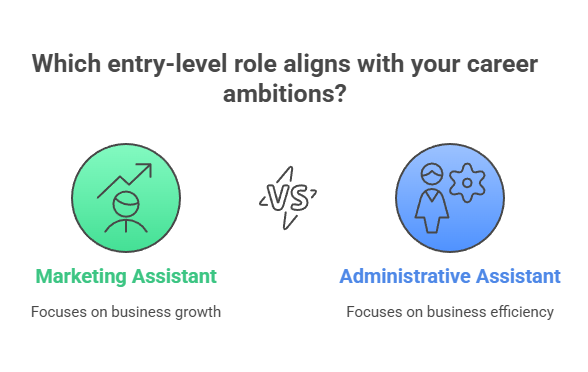
This comprehensive guide will provide a deep, data-driven comparison of these two roles. We will dissect their responsibilities, required skills, salary potential, and long-term career paths. Drawing on insights from the U.S. Bureau of Labor Statistics and analyzing the real-world impact of AI, we will equip you with the knowledge to decide which path best aligns with your ambitions in the 2025 job market and beyond.
The Fundamental Divide: Creative Growth vs. Operational Excellence
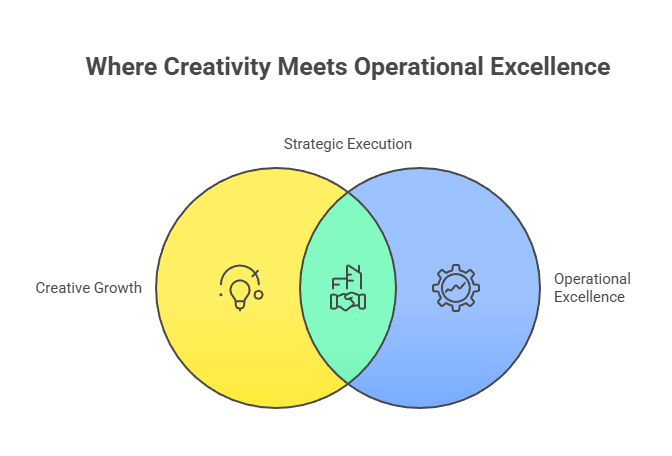
Before diving into salaries and daily tasks, it’s vital to understand the philosophical difference between these two careers. One is about creating forward momentum through external communication, while the other is about creating internal stability through flawless execution. Understanding this core distinction is the first step in aligning your personal strengths with the right professional trajectory.
What is a Marketing Assistant? The Engine of Campaign Execution

A Marketing Assistant is an active participant in the machinery of business growth. They are the essential support system for the marketing department, directly contributing to initiatives designed to attract, engage, and convert customers. Their work is dynamic, project-based, and often requires a blend of creative thinking and analytical rigor.
Their purpose is to help bring marketing strategies to life. A marketing support specialist might spend their morning drafting social media copy for a new product launch and their afternoon analyzing the open rates from a recent email campaign in Mailchimp. They are on the front lines of digital marketing, helping to manage a brand’s public-facing presence and measure its impact using tools like Google Analytics.
What is an Administrative Assistant? The Backbone of Business Operations
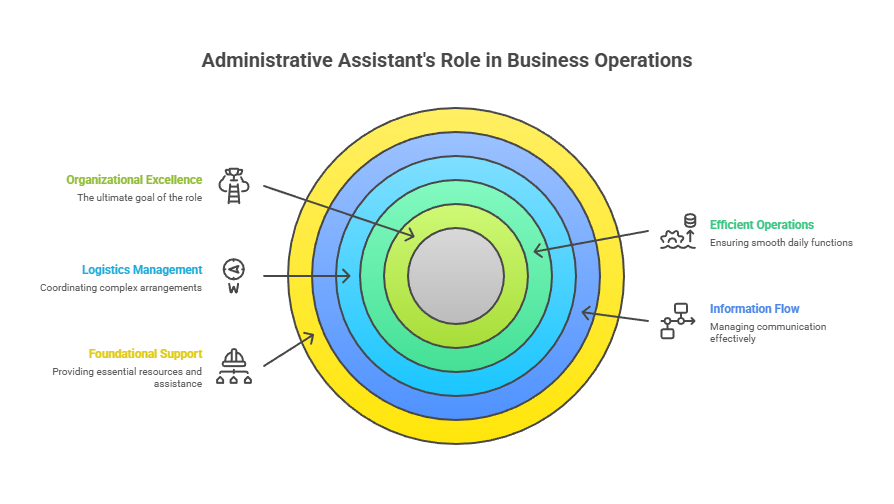
An Administrative Assistant is the central nervous system of a department or an executive team. Their primary function is to create an environment where others can work at peak efficiency. They manage the flow of information, coordinate complex logistics, and ensure that daily operations run without a hitch. Their role is the definition of organizational excellence.
The work of an Administrative Assistant is foundational. A typical day might involve coordinating a complex international travel itinerary for an executive, preparing a detailed PowerPoint presentation from raw notes, and onboarding a new employee by ensuring they have all the necessary resources. Their mastery of tools like Microsoft Office Suite, Google Workspace, and internal communication platforms like Slack is indispensable to organizational success.
Why This Distinction Is Critical in the 2025 Job Market

The current economic climate has sharpened the focus on the unique value each role provides. Companies facing tight budgets are demanding a clear return on investment from their marketing efforts. This elevates the importance of a Marketing Assistant who understands data and can contribute to campaigns that generate measurable results.
Simultaneously, the corporate push for leaner operations and higher productivity makes a technologically adept Administrative Assistant more valuable than ever. An assistant who can leverage automation and AI to streamline workflows is not just a support function; they are a strategic asset who creates efficiency and saves the company valuable time and money.
A Head-to-Head Comparison: Responsibilities, Skills, and Tools
While both roles require a high degree of professionalism and strong communication skills, their day-to-day functions, the tools they use, and the specific talents they cultivate are vastly different. Examining these details is key to understanding where you would not only succeed but also thrive.
A Day in the Life: Comparing Daily Tasks and Responsibilities
A look at a typical Marketing Assistant job description reveals a focus on campaign-related activities. Their tasks are often varied and tied to the rhythm of the marketing calendar.

A Marketing Assistant’s day may include:
- Updating and maintaining the company’s Customer Relationship Management (CRM) system, such as Salesforce or HubSpot.
- Scheduling a week’s worth of social media posts across multiple platforms using a tool like Hootsuite.
- Conducting basic keyword research for an upcoming blog post to improve SEO.
- Assisting with the logistical coordination of a virtual webinar or in-person trade show.
- Compiling data from recent campaigns to contribute to a weekly performance report.
Conversely, an Administrative Assistant job description emphasizes structure, support, and process management. Their responsibilities are geared toward enabling the productivity of others.
An Administrative Assistant’s day may involve:
- Managing and deconflicting multiple complex calendars for a team of executives.
- Preparing and submitting detailed expense reports with meticulous accuracy.
- Attending meetings, taking comprehensive minutes, and distributing action items.
- Handling confidential documents and correspondence with the utmost discretion.
- Managing office inventory and liaising with vendors to ensure supplies are stocked.
The Modern Toolkit: Technologies Shaping Each Profession
Technical proficiency is no longer a footnote on a resume; it is a core competency for both professions. However, the specific technologies they are expected to master are quite different.
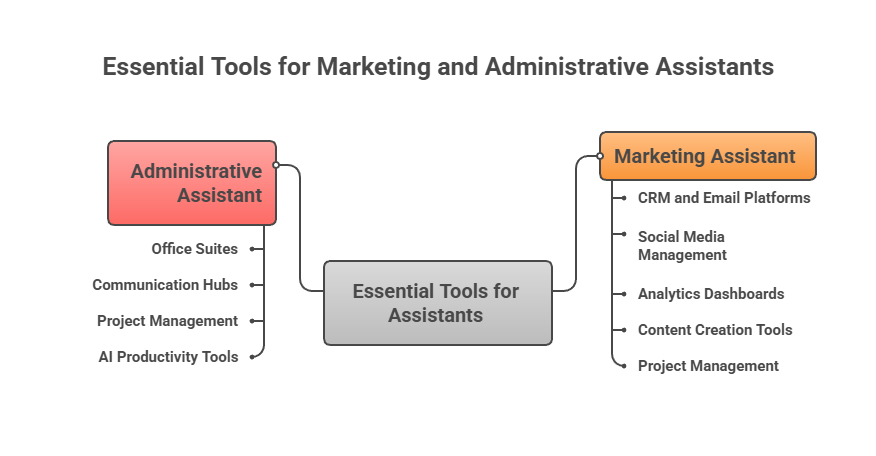
A Marketing Assistant operates within the marketing technology stack. Their toolkit includes:
- CRM and Email Platforms: HubSpot, Salesforce, Mailchimp.
- Social Media Management: Hootsuite, Buffer, Sprout Social.
- Analytics Dashboards: Google Analytics, SEMrush.
- Content Creation Tools: Canva, Adobe Creative Suite basics.
- Project Management: Asana, Trello (often shared with other teams).
An Administrative Assistant must be a power user of office productivity and collaboration software. Their essential tools are:
- Office Suites: Advanced skills in Microsoft 365 (Word, Excel, PowerPoint, Outlook) and Google Workspace are non-negotiable.
- Communication Hubs: Slack, Microsoft Teams.
- Project Management: Asana, Trello, Monday.com.
- AI Productivity Tools: A growing expectation is familiarity with AI assistants like Microsoft Copilot or AI-powered scheduling tools to optimize workflows.
At-a-Glance Role Breakdown

This table provides a clear, side-by-side summary to help visualize the core differences between these two vital roles.
| Feature | Marketing Assistant | Administrative Assistant |
| Primary Goal | Drive marketing campaigns & lead generation | Ensure operational efficiency & support management |
| Key Metrics | Engagement rates, lead counts, campaign ROI | Task completion rate, executive productivity, accuracy |
| Core Skills | SEO, Content Creation, Social Media, Data Analysis | Organization, Time Management, Tech Proficiency, Communication |
| Common Tools | HubSpot, Google Analytics, Mailchimp, Asana | Microsoft 365, Slack, Google Workspace, SAP |
| Work Environment | Project-based, collaborative, often creative | Task-oriented, procedural, supportive |
| Success Looks Like | A successful campaign that exceeds its goals | A seamless week for an executive or department |
Salary, Job Outlook, and Economic Realities in the U.S. Market
When planning a career, understanding the financial prospects and long-term stability of a role is paramount. The salary potential and job outlook for marketing and administrative professionals are influenced by industry demand, geographic location, and the ongoing evolution of their responsibilities.
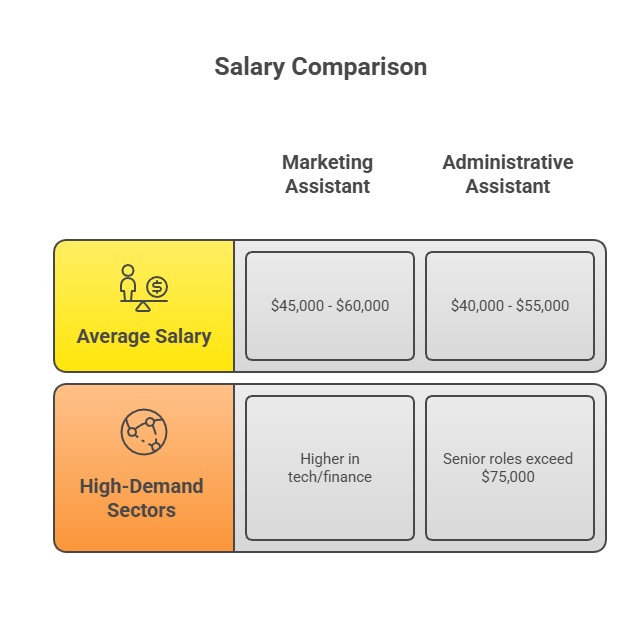
Analyzing the Paycheck: A Realistic Salary Comparison
Compensation for both roles can vary significantly based on experience, industry, and the cost of living in a particular city. However, national averages provide a useful benchmark for what you can expect.
The average Marketing Assistant salary in the United States typically falls between $45,000 and $60,000 per year. In high-demand sectors like technology or finance, or in major metropolitan areas, this figure can be considerably higher.
The average Administrative Assistant salary is generally in the range of $40,000 to $55,000 annually. Senior Executive Assistants who support C-level leadership can command much higher salaries, often exceeding $75,000 or more, reflecting their critical role and extensive experience.
Job Growth Projections (2024-2034): Interpreting the BLS Data
The U.S. Bureau of Labor Statistics (BLS) provides authoritative data on employment projections, offering a glimpse into the future demand for various professions.

The job outlook for marketing assistants and related roles is quite positive. The BLS projects that employment for advertising, promotions, and marketing managers will grow 6 percent from 2024 to 2034, which is faster than the average for all occupations. This growth is directly tied to the increasing importance of digital marketing and the need for organizations to maintain a competitive edge online.
For administrative professionals, the picture is more nuanced. The job outlook for administrative assistants is expected to show little or no change over the next decade. However, this does not mean jobs are disappearing. The BLS still projects thousands of openings each year due to the need to replace workers who retire or transition to other careers. This highlights a shift in the nature of the role rather than its obsolescence.
How AI and Economic Headwinds Are Reshaping These Roles
The current economic landscape is acting as a catalyst for change in both fields. The impact of budget cuts on marketing roles means that companies are scrutinizing every dollar spent. A Marketing Assistant who can demonstrate their contribution to lead generation and sales is far more valuable than one focused solely on less measurable brand awareness activities.

Meanwhile, the conversation around the future of administrative assistant jobs with AI is evolving. Rather than replacing assistants, AI is automating their most repetitive tasks, such as scheduling and data entry. This frees them up to focus on higher-value activities like project management, event planning, and complex problem-solving, effectively elevating the position into a more strategic operational role.
Charting Your Future: Career Paths and Growth Opportunities
An entry-level job should be a stepping stone, not a final destination. Both the Marketing Assistant and Administrative Assistant roles offer robust and rewarding career paths for ambitious professionals who are committed to continuous learning and development.
The Marketing Trajectory: From Assistant to Strategist
A Marketing Assistant position is an exceptional launchpad into the diverse world of marketing. It provides foundational experience across multiple disciplines, allowing individuals to discover their passions and specialize over time. A common career progression looks like this:
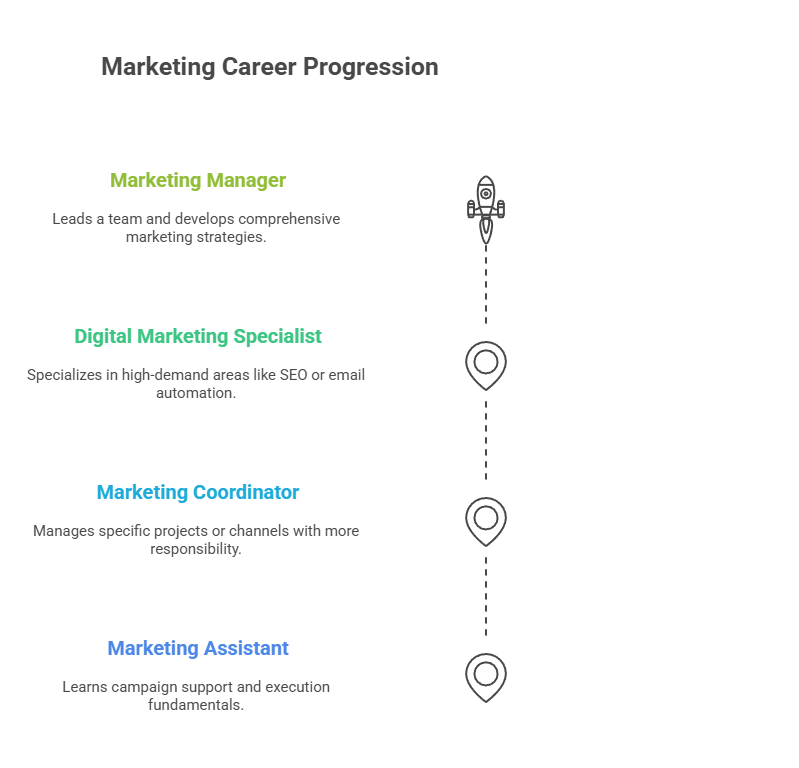
- Marketing Assistant: Learns the fundamentals of campaign support and execution.
- Marketing Coordinator: Takes on more responsibility for managing specific projects or channels.
- Digital Marketing Specialist: Specializes in a high-demand area like SEO, PPC, or email automation.
- Marketing Manager: Leads a team and develops comprehensive marketing strategies.
The Administrative Ladder: From Support to Management
The career path for an Administrative Assistant is one of increasing responsibility, trust, and influence. It is a trajectory that rewards meticulousness, foresight, and exceptional interpersonal skills. The advancement path often includes:
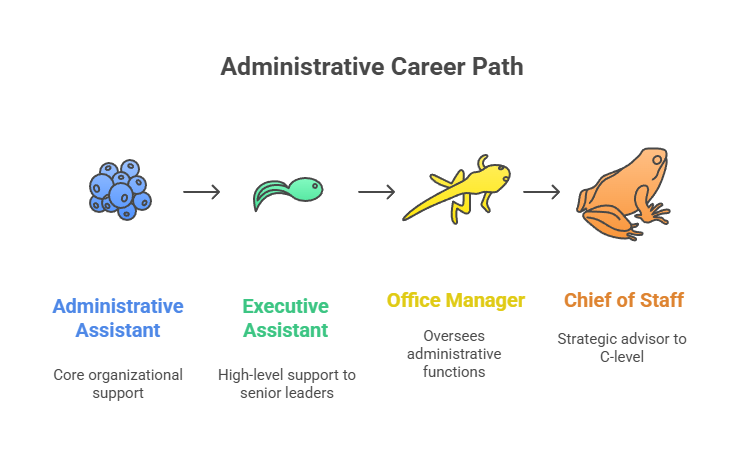
- Administrative Assistant: Masters the core tasks of organizational support.
- Executive Assistant: Provides dedicated, high-level support to one or more senior leaders.
- Office Manager: Oversees the entire administrative function and operations of an office.
- Chief of Staff: Acts as a strategic advisor and right-hand to a C-level executive.
The Transition Pathway: Moving from Administrative to Marketing Roles
One of the most powerful aspects of starting in an administrative role is the deep understanding you gain of how a business truly operates. This unique perspective can be a significant advantage for those looking to transition from administrative assistant to marketing. This move requires a strategic approach to upskilling.
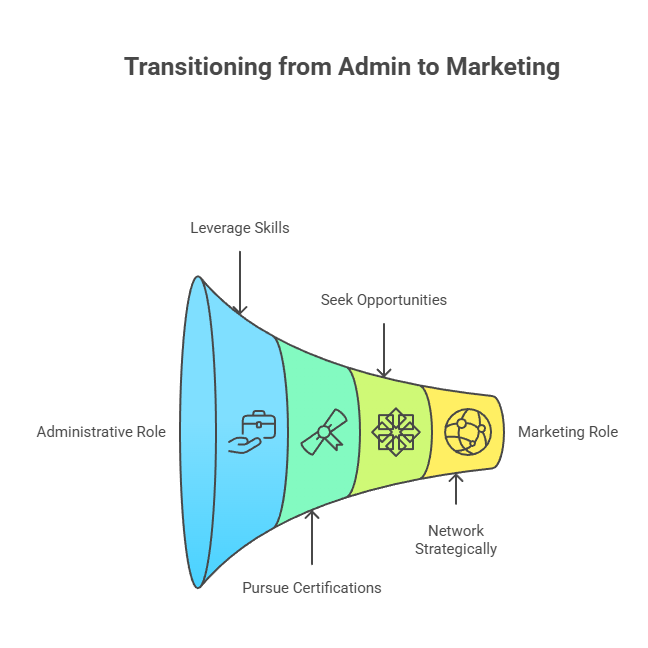
Actionable steps for making the switch include:
- Leverage Transferable Skills: Highlight your expertise in project management, communication, and budget tracking on your resume.
- Pursue Certifications: Complete online certifications in Google Analytics, HubSpot Inbound Marketing, or Meta Blueprint to build a credible marketing skillset.
- Seek Internal Opportunities: Volunteer to help the marketing team with a project, proofread a newsletter, or assist with event planning.
- Network Strategically: Inform your manager and colleagues in the marketing department of your career goals.
Skills for Future-Proofing Your Career

Regardless of the path you choose, proactive upskilling is essential for long-term success. This table outlines key areas where you can invest in your professional development to stay ahead of the curve.
| Role | Core Skill to Master | Upskilling Opportunity | Long-Term Value |
| Marketing Assistant | Data Analysis (Google Analytics) | Learn Marketing Automation (HubSpot) | Become a data-driven decision-maker, essential for proving ROI. |
| Marketing Assistant | Content Creation | Develop Video Editing/Production Skills | Capitalize on the dominance of short-form and long-form video content. |
| Administrative Assistant | Tech Proficiency (Microsoft 365) | Master AI Productivity Tools (e.g., Copilot) | Evolve from a task-doer to a technology-leveraging efficiency expert. |
| Administrative Assistant | Project Coordination | Get a Certification (e.g., CAP, PMP) | Transition into higher-paying project management or operational roles. |
Which Role Is Right for You? A Self-Assessment Guide
The best career choice is one that aligns with your natural talents, your personality, and your long-term ambitions. Answering a few honest questions can provide clarity and help guide your decision in the Marketing Assistant vs. Administrative Assistant comparison.
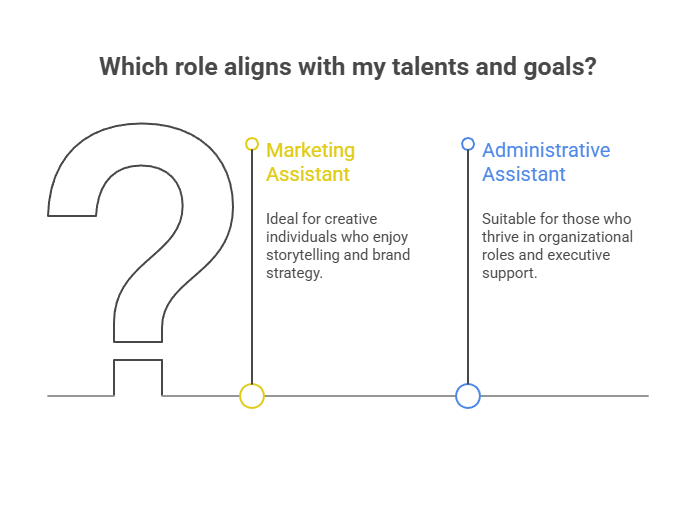
Are You a Creative Storyteller or an Organizational Architect?
Consider which of these statements resonates more with you. Do you find energy in brainstorming new ideas, analyzing what makes an audience tick, and seeing a creative campaign come to life? Or do you find deep satisfaction in creating order from chaos, building efficient systems, and anticipating the needs of others to ensure everything runs smoothly? The former points toward marketing, the latter toward administration.
Aligning Your Choice with Long-Term Career Goals
Think about where you want to be in five to ten years. If your goal is to lead a creative team, develop brand strategy, or become an expert in a specialized digital field, the Marketing Assistant path provides the most direct route. If you aspire to become an indispensable operational leader, manage a team, or work at the highest levels of executive support, the Administrative Assistant role offers a clear and proven ladder.
Conclusion: Making a Strategic Career Choice in an Era of Change
The decision between a career as a Marketing Assistant versus an Administrative Assistant is a choice between two equally vital, yet fundamentally different, professional paths. One is dedicated to driving the external growth of a business, while the other is committed to fortifying its internal operational strength. Both roles are being actively reshaped by technology and the economy, making adaptability, tech-savviness, and a commitment to continuous learning the true keys to success.
Ultimately, the right choice is not about which job title sounds better or which role is perceived as superior. It is about a thoughtful assessment of your own skills, passions, and professional ambitions. By understanding the distinct responsibilities, skills, and future trajectories of each path, you can make a strategic decision that serves not just as your next job, but as the foundational first step in a long and fulfilling career.
Frequently Asked Questions (FAQs)
What is the main difference between a Marketing Assistant and an Administrative Assistant?
The main difference is their core function. A Marketing Assistant supports marketing campaigns to drive business growth, focusing on creative and analytical tasks. An Administrative Assistant supports people and departments to ensure operational efficiency, focusing on organizational and procedural tasks.
Which role typically pays more: a Marketing Assistant or an Administrative Assistant?
On average, the starting salary for a Marketing Assistant is often slightly higher due to the specialized skills required. However, a senior-level Executive Assistant supporting top executives can earn significantly more than many mid-level marketing professionals.
What are the key skills I need to become a Marketing Assistant in 2026?
Essential skills include digital marketing basics (SEO, social media), data analysis using tools like Google Analytics, content creation abilities, and familiarity with CRM software like HubSpot or Salesforce.
How is Artificial Intelligence (AI) changing the role of an Administrative Assistant?
AI is automating routine administrative tasks like scheduling, transcription, and data entry. This is shifting the role to focus on higher-value responsibilities such as project management, complex problem-solving, and managing the implementation of new technologies.
Is a Marketing Assistant a good entry-level position for a career in digital marketing?
Absolutely. It is one of the best entry-level roles as it provides broad exposure to various facets of marketing, including content, social media, email, and analytics, allowing you to build a strong foundation and discover areas for specialization.
Can I become a Marketing Assistant with no prior marketing experience?
Yes, it is possible. You can strengthen your candidacy by earning online marketing certifications, creating a portfolio of personal projects (like running a blog or social media account), and highlighting transferable skills from other jobs, such as communication and project coordination.
What does the career path for an Administrative Assistant look like?
A common career path progresses from Administrative Assistant to Executive Assistant, then to Office Manager or a specialized role like Project Coordinator. At the highest levels, one can become a Chief of Staff to a C-level executive.
How has the current economic situation in the U.S. affected hiring for these roles?
Companies are being more selective. For marketing roles, they are prioritizing candidates with data analysis skills who can demonstrate ROI. For administrative roles, they are seeking highly efficient, tech-savvy professionals who can help streamline operations and reduce costs.
Are Administrative Assistant jobs at risk of being fully automated?
No. While routine tasks are being automated, the core functions of the role that require critical thinking, interpersonal skills, and complex problem-solving are not easily replaced by AI. The role is evolving, not disappearing.
What software and tools are essential for a Marketing Assistant to know?
Key tools include Google Analytics, a CRM platform (HubSpot/Salesforce), an email marketing service (Mailchimp), social media schedulers (Hootsuite/Buffer), and project management software (Asana/Trello).
Is it possible to switch from an Administrative Assistant role to a Marketing Assistant role?
Yes, this is a common and achievable career transition. Success requires strategically upskilling in digital marketing fundamentals, earning relevant certifications, and effectively highlighting your transferable organizational and project management skills.
Which of these two roles offers more opportunities for remote work?
Both roles have seen a significant increase in remote opportunities. However, digital marketing assistant roles are often more inherently remote-friendly, as most of their tasks are computer-based. Administrative roles, especially those supporting on-site teams or managing physical office spaces, may require more in-person presence.








